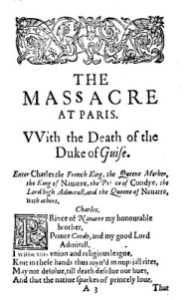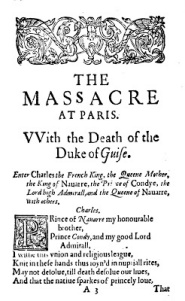The Massacre at Paris by Christopher Marlowe is a historical drama written in the context of the great sociopolitical and religious disturbance that took place between the Catholics and the French Protestants or Huguenots during the 16th century in Europe.
Marlowe’s classic play “The Massacre at Paris” is based on the actual events that took place on St Bartholomew’s Day in Paris in 1574. The play was first performed in 1593.
The Massacre at Paris Summary
The play begins with the marriage ceremony of Huguenot noble Henry of Navarre to Margaret of Valois, daughter of Catherine de Medici, the Catholic Queen. The marriage was an attempt to put an end to the civil war between the two religious’ sects, but both the Catholics and the Huguenots deeply condemned the marriage.
The Queen mother, Catherine de Medici was especially unhappy with the arrangement and her together with the Duke of Guise makes a plot to murder the Queen of Navarre. It is believed that the marriage was in fact a trap that the Queen mother Catherine has diligently planned out to eradicate the Huguenots.

The Queen of Navarre is poisoned and her Admiral is shot by one of Guise’s men. The admiral is injured and Charles, the King of France visit him to give him his condolences.
The admiral does not escape death but is killed by Guise’s nobles while in sleep in his bed. The news of the massacre spreads to all over Europe and to Paris. Henry of Navarre is held in the palace.
An army of nobles led by Guise is driven by revenge and they seek to kill any Huguenot who is in relationship with Henry of Navarre. The Queen Mother is happy with the consequences and he calls in her son to be crowned Henry III of France.
Navarre escapes and returns to his homeland. He soon realizes that Guise is raising an army of men led by General Joyeux. Navarre soon raises his own battalion and sends them to counterattack the French army. He soon receives the news of their victory against the French army and Joyeux who has been killed in the battle.
The defeat infuriates Henry III who is ready to get rid of Guise. The news reaches Guise and Navarre sends an invitation to Guise to join forces against the French army.
Henry III invites Guise to his royal court in Blois and gets Guise killed by assassins. The word of Guise’s death spreads throughout the country. Henry III also plans to kill Guise’s brother Dumaine to reduce any risk of revenge. Dumaine seeks to avenge the death of his brother and join hands with Jacobin a friar.
The Queen mother is severely dissatisfied by Henry III’s actions. Navarre joins forces with two French kings and together they led forces against the Catholics in Paris.
In the final act, friar pretending to deliver a letter stabs Henry. The friar is also killed in the brawl. Henry III is severely injured and there is no chance for his survival. He thereby proposes Navarre as the next king to his throne.
The play ends with the crowning of Navarre as King Henry the IV with a pledge of taking further revenge against the Catholics of France.

Check out some of Marlowe’s famous monologues
Famous Plays by Christopher Marlowe
Famous poems by Christopher Marlowe
The Inevitable Day Poem by Christopher Marlowe
Enter A Spy, The Double Life of Christopher Marlowe
Christopher Marlowe Famous Quotes
Christopher Marlowe Vs William Shakespeare Comparison
